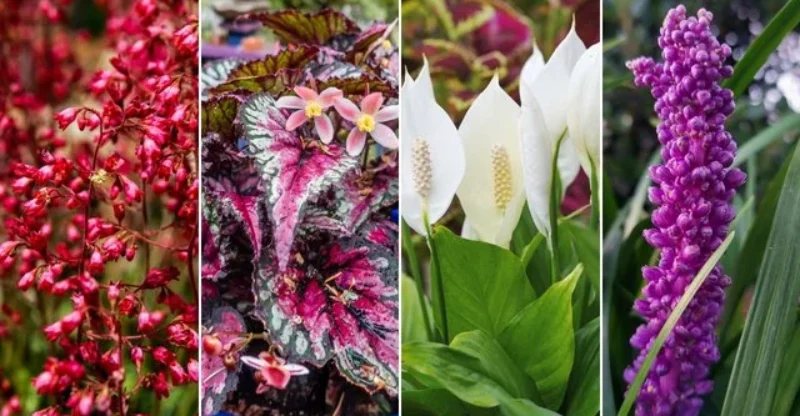8 Best Plants for a Courtyard Garden to Maximize Small Spaces
A courtyard garden is an excellent way to add beauty, greenery, and tranquility to small outdoor spaces. However, when space is limited, it’s essential to choose plants that not only look good but can thrive in tight spaces. The right plants can make your courtyard feel spacious and lush, even in the smallest areas.
When choosing plants for your courtyard, you should consider several factors, such as light conditions, soil type, and the maintenance requirements of each plant.
Some plants may require more sunlight, while others thrive in shaded areas. Additionally, certain plants may need more regular watering or pruning to stay healthy.
In this guide, we’ll explore 8 fantastic plants that are ideal for small courtyards. We’ll go into detail about how to grow each of these plants, the skills you’ll need, and what tools and equipment are essential for successful gardening.
Whether you’re a beginner or an experienced gardener, this blog will provide you with the knowledge needed to transform your courtyard garden into a green paradise.
1. Ferns
Ferns are a fantastic plant for small spaces, especially in shady courtyards. These plants are highly adaptable and come in a variety of species, making them suitable for different types of gardens. Ferns are perfect for adding a soft, lush, green look to your courtyard, especially in areas that do not get much sunlight.
How to Grow
Ferns prefer moist, well-drained soil and can be grown in partial to full shade. While they do need regular watering, it’s important to avoid overwatering, as ferns are susceptible to root rot. To grow ferns successfully, you’ll need to maintain the right balance of moisture and light.
Skills Needed
Growing ferns requires basic gardening skills. Understanding the water and light needs of ferns is essential for their survival. You’ll also need to monitor humidity levels, as ferns thrive in humid environments.
Equipment
- Soil: Well-draining potting mix or loamy soil
- Watering tools: A gentle watering can with a fine nozzle or a drip irrigation system
- Fertilizer: Balanced liquid fertilizer for ferns (use once a month during the growing season)
- Pruning tools: Small pruning shears for trimming dead fronds
2. Coral Bells
Coral bells, or Heuchera, are known for their vibrant, colorful leaves and delicate flowers. These plants are low-maintenance, making them an excellent choice for a small courtyard garden. They can grow in both sun and partial shade, making them very versatile.
How to Grow
Coral bells thrive in well-draining, slightly acidic soil. They should be planted in locations where they receive indirect light, though some varieties can tolerate more sunlight. These plants do well in containers or directly in the ground and can even handle dry periods once established.
Skills Needed
Growing coral bells requires moderate knowledge of soil pH and watering techniques. You should also be familiar with dividing plants every few years to keep them healthy.
Equipment
- Soil: Well-draining, acidic soil (mix in compost for better growth)
- Watering tools: A watering can with a gentle spout or a soaker hose to prevent waterlogging
- Fertilizer: Slow-release fertilizer or organic compost for better leaf color
- Pruning tools: Pruning shears for deadheading spent flowers and removing damaged leaves
3. Begonia
Begonias are another popular plant for small spaces. They have attractive foliage and bright, colorful flowers that can bloom all year round. With their ability to thrive in containers, begonias are perfect for courtyards with limited space.
How to Grow
Begonias prefer rich, well-drained soil and need moderate watering. They enjoy indirect light, so they’re great for shaded corners of your courtyard. You can grow begonias from seeds, tubers, or cuttings. If you live in a colder climate, begonias may need to be brought indoors during the winter.
Skills Needed
Growing begonias requires knowledge of light levels, soil moisture, and temperature control. If you plan to propagate begonias, you’ll need experience in taking cuttings or working with tubers.
Equipment
- Soil: Rich, well-draining potting mix with organic matter
- Watering tools: A watering can with a small spout or self-watering pots
- Fertilizer: Balanced liquid fertilizer every 2-3 weeks during the growing season
- Pots: Decorative containers for both indoor and outdoor planting
- Pruning tools: Pruning shears for removing dead flowers and leaves
4. Hosta
Hostas are large-leaved plants known for their stunning foliage, which can range from green to blue to yellow. They thrive in shady areas and make a bold statement in small gardens, providing texture and volume.
How to Grow
Hostas prefer moist, well-drained soil and thrive in partial to full shade. They are perfect for areas with low sunlight, such as the north-facing side of a courtyard. Hostas grow best when their roots are consistently moist but not waterlogged.
Skills Needed
Hostas are relatively easy to grow, but they do require some knowledge of soil preparation and drainage. You’ll need to ensure that the plants are not overcrowded, as they can become susceptible to diseases if overcrowded.
Equipment
- Soil: Rich, well-draining soil mixed with organic compost
- Watering tools: A soaker hose or a deep watering can to ensure roots are watered properly
- Fertilizer: Balanced organic fertilizer or compost in early spring
- Mulch: Organic mulch to maintain moisture and keep roots cool
- Pruning tools: Sharp scissors to cut back damaged leaves
5. Lilyturf
Lilyturf (also known as Mondo grass) is an excellent groundcover plant that grows in neat clumps. It’s perfect for small courtyards as it doesn’t take up much space and provides an interesting texture to the garden.
How to Grow
Lilyturf thrives in a variety of soil types, but it prefers well-drained soil. It can tolerate both sun and shade, making it ideal for different parts of your courtyard. Regular watering is necessary, but once established, this plant is quite drought-tolerant.
Skills Needed
Growing lilyturf requires basic knowledge of soil types and watering techniques. You should also understand how to manage its spreading habit, as it can spread over time if left unchecked.
Equipment
- Soil: Well-draining soil, preferably loamy or sandy
- Watering tools: A watering can or drip irrigation for consistent moisture
- Fertilizer: Slow-release fertilizer in spring for healthy growth
- Pruning tools: A spade for dividing clumps and pruning shears for cutting back old growth
6. Palms
Palms add a tropical feel to any courtyard garden. Smaller palms like the pygmy date palm or dwarf fan palm are ideal for tight spaces. These plants can grow in containers, making them perfect for small courtyards.
How to Grow
Palms prefer well-drained, slightly acidic soil. They thrive in bright, indirect light and should be watered deeply but infrequently. Overwatering can lead to root rot, so it’s important to let the soil dry out between waterings.
Skills Needed
Growing palms requires moderate experience with container gardening, as palms often do better in pots. You also need to be familiar with the right soil mix and how to manage watering schedules.
Equipment
- Soil: Well-draining, slightly acidic soil mix, often with added sand or perlite
- Watering tools: A watering can with a long spout or a drip irrigation system
- Fertilizer: Palm-specific fertilizer or slow-release fertilizer during the growing season
- Pruning tools: Pruning shears to remove dead fronds
7. Peace Lily
The peace lily is a popular indoor and outdoor plant, known for its glossy green leaves and elegant white flowers. It’s easy to grow and adds a touch of sophistication to any courtyard.
How to Grow
Peace lilies grow well in indirect light and prefer moist, well-drained soil. They’re relatively low-maintenance and only need occasional watering. Peace lilies also help purify the air, making them a great addition to your garden.
Skills Needed
Growing peace lilies is quite simple, but understanding the importance of maintaining humidity and soil moisture is crucial. You should also know how to repot peace lilies every 1-2 years.
Equipment
- Soil: Well-draining potting mix with organic matter
- Fertilizer: Balanced liquid fertilizer once a month during the growing season
- Pruning tools: Pruning shears to remove dead flowers and yellowing leaves
8. Caladium
Caladiums are known for their striking, colorful leaves. They come in various shades, including red, pink, white, and green. These plants love the warmth, so they’re great for courtyards that get plenty of sunlight.
How to Grow
Caladiums prefer moist, well-draining soil. They thrive in warm conditions and should be planted in areas that receive full or partial sunlight. You can grow caladiums from bulbs or tubers, and they’re excellent for containers as well as in-ground gardens.
Skills Needed
Growing caladiums requires knowledge of soil moisture levels and light exposure. You should also be able to manage their growing season and prepare them for winter in colder climates.
Equipment
- Soil: Well-draining, rich, organic soil
- Watering tools: A watering can with a spout or drip irrigation system
- Fertilizer: Balanced fertilizer for tubers during the growing season
- Mulch: To retain moisture and prevent weeds
- Pruning tools: To trim old or damaged leaves
Conclusion
Choosing the right plants for your small courtyard garden is all about selecting varieties that will thrive in your space and provide the aesthetic you’re looking for. From low-maintenance ferns to colorful begonias, these 8 plants offer beauty, texture, and easy care. By understanding the growth requirements, using the right tools, and having the necessary skills, you can create a vibrant, inviting garden that maximizes even the smallest of spaces.



